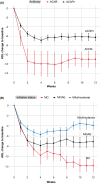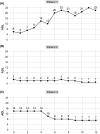Efgartigimod for generalized myasthenia gravis: A multicenter real-world cohort study in China
- PMID: 38973109
- PMCID: PMC11330228
- DOI: 10.1002/acn3.52142
Efgartigimod for generalized myasthenia gravis: A multicenter real-world cohort study in China
Erratum in
-
Correction to "Efgartigimod for Generalized Myasthenia Gravis: A Multicenter Real-World Cohort Study in China".Ann Clin Transl Neurol. 2025 Sep;12(9):1947. doi: 10.1002/acn3.70126. Epub 2025 Jul 1. Ann Clin Transl Neurol. 2025. PMID: 40590525 Free PMC article. No abstract available.
Abstract
Objective: Efgartigimod, a neonatal Fc receptor antagonist, facilitates antibody degradation including pathogenic IgGs. The ADAPT study demonstrated the tolerability and efficacy of efgartigimod in the treatment of generalized myasthenia gravis (gMG). However, very limited evidence is available for the Chinese population, and it remains inconclusive about which kind of patients are selected to preferentially receive efgartigimod in real-world settings.
Methods: This multicenter cohort study included gMG patients treated at 14 neuromuscular reference centers in China. The Myasthenia Gravis Activities of Daily Living (MG-ADL) score, immunosuppressants, and the incidence of treatment-emergent adverse events (TEAEs) were prospectively collected.
Results: Of the 1640 gMG admitted between September and December 2023, 61 (3.7%) received efgartigimod for at least one treatment cycle. Among them, 56 cases (92%) were anti-AChR antibody-positive, 4 were anti-MuSK antibody-positive, and 1 was seronegative. Thymoma-associated myasthenia gravis accounted for most cases (44%, 27 out of 61). The principal causes of efgartigimod initiation included MG acute exacerbation (MGAE) (48%, 29 out of 61) and myasthenic crisis (MC) (15%, 9 out of 61). Clinically meaningful improvement was rapidly achieved in 97% (58 out of 61) of patients at 1.3 ± 0.7 weeks. By week 12, the MG-ADL score reduced to 3.8 ± 4.1 (baseline:10.5 ± 5.2) for all participants, while it reduced to 4.0 ± 4.7 for MGAE and 3.8 ± 4.2 for MC, respectively. All but one TMG patient required no additional rescue therapies after efgartigimod initiation. 11.5% (7 out of 61) reported ≥1 TEAEs.
Interpretation: This multicenter cohort study demonstrated the efficacy of efgartigimod in rapid control of gMG. Patients with MGAE or MC would benefit from efgartigimod treatment.
© 2024 The Author(s). Annals of Clinical and Translational Neurology published by Wiley Periodicals LLC on behalf of American Neurological Association.
Conflict of interest statement
The authors declare that the research was conducted in the absence of any commercial or financial relationships that could be construed as a potential conflict of interest.
Figures



References
-
- Huijbers MG, Marx A, Plomp JJ, le Panse R, Phillips WD. Advances in the understanding of disease mechanisms of autoimmune neuromuscular junction disorders. Lancet Neurol. 2022;21(2):163‐175. - PubMed
-
- Murai H, Utsugisawa K, Motomura M, Imai T, Uzawa A, Suzuki S. The Japanese clinical guidelines 2022 for myasthenia gravis and Lambert–Eaton myasthenic syndrome. Clinical Exp Neuroim. 2023;14(1):19‐27.
Publication types
MeSH terms
Substances
Grants and funding
LinkOut - more resources
Full Text Sources
Medical
